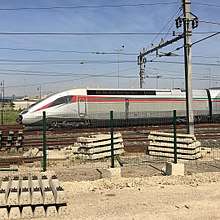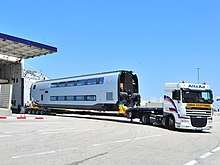Euroduplex
| Euroduplex | |
|---|---|
|
Euroduplex at the Karlsruhe Hauptbahnhof at the entrance | |
| In service | 2011–present |
| Manufacturer | Alstom |
| Family name | TGV |
| Constructed | 2011–2019 |
| Entered service | 2011–present |
| Number in service |
124 trainsets (planned) (110 SNCF, 14 ONCF) |
| Formation |
10 cars (2 power cars + 8 trailers) |
| Fleet numbers | 801 - 825, 4701 - 4730 (SNCF) |
| Capacity |
509 seats (SNCF, 55 trainsets) 556 seats (SNCF, 55 trainsets) 533 seats (ONCF) |
| Operator(s) |
SNCF (France) ONCF (Morocco) |
| Specifications | |
| Train length | 200.19 m (656 ft 9 in) |
| Car length |
Power car: 22,150 mm (72 ft 8 in) End car: 21,845 mm (71 ft 8.0 in) Intermediate car: 18,700 mm (61 ft 4 in) |
| Width | 2,904 mm (9 ft 6.3 in) |
| Height | 4,320 mm (14 ft 2 in) |
| Doors | One per side per passenger car |
| Maximum speed | 320 km/h (199 mph) |
| Weight | 399 t (393 long tons; 440 short tons) |
| Traction motors | 8 x Alstom 6 FHA 1,160 kW (1,560 hp) AC asynchronous motors |
| Power output |
9,280 kW (12,440 hp) (25 kV 50 Hz AC 3,680 kW (4,930 hp) (1,500 V DC) |
| Electric system(s) |
25 kV 50 Hz AC 15 kV 16 2⁄3 Hz AC 3,000 V DC 1,500 V DC Overhead catenary |
| Current collection method | Pantograph |
| UIC classification | Bo'Bo'+2'2'2'2'2'2'2'2'2'+Bo'Bo' |
| Braking system(s) | Regenerative and pneumatic |
| Safety system(s) | ERTMS, ETCS, KVB, TVM 430, ASFA, LZB, PZB, ZUB, Integra |
| Coupling system | Scharfenberg |
| Multiple working | Up to two trains |
| Track gauge | 1,435 mm (4 ft 8 1⁄2 in) standard gauge |
The SNCF TGV 2N2, ONCF RGV 2N2 or most commonly called Euroduplex, is the 3rd generation of the TGV Duplex (after the TGV Dasye), in construction since 2011 by Alstom in Belfort and Aytré (near La Rochelle). It has entered commercial operation by the French national railway company on 11 December 2011.[1] Sixty five trains from the SNCF are also named L'Océane, after the inauguration of the LGV L'Océane.
These trains are interoperable, containing equipment allowing them to travel between several european continental countries with various types of electrification and signalling systems such as France, Germany, Switzerland, Spain and Luxembourg. A Moroccan variation will be the first high speed train to operate in Africa.
Description
The TGV 2N2 trains are an evolution of the TGV Duplex Dasye and still share the main features. The drive is of type TGV POS asynchronous traction motors, European signaling system European Rail Traffic Management System. The trailers feature new interiors, electric sockets fitted in both classes and improved information systems.
The main differences with the TGV Duplex Dasye:
- UIC loading gauge with more headroom upstairs
- Improved windows
- Passenger Information System (SIVE) with voice announcements as in the TER trains.
- Outside SIVE dynamic light display indicating the number of the train, its route and the number of the car
- Fixed filler gaps on all doors,
- Control over the train hot boxes (two sensors per box for redundancy)
- Overall control of each axle
- Improved accessibility for wheelchairs[2]
History
Riding on the success of the concept TGV Duplex and praised by customers, the company decided to develop a fleet of interoperable trains, especially suitable for 15 kV 16 ⅔ Hz (only 8 trains TGV Sud-Est could operate at this current and 19 trains are then TGV POS), the train is a tricurrent version of TGV Duplex.
In parallel with the development of high-speed lines internationally, Alstom SA won a tender for the supply of equipment for high-speed TGV Morocco, the first high-speed train on the African continent.
Operators
SNCF

In June 2007,[3] in addition to 25 extra TGV Dasye sets (+ 3 others 2008), the SNCF has placed a large order for 55 Alstom tricurrent high speed trains, TGV 2N2.
These 55 trains can be divided into:
- 30 trains "3UA" (tricurrent Germany), numbered 4701-4730 (4 international) for services from France to Germany and Switzerland. Prototypes were tested from August 2010, the remaining deliveries expected between 2011 and 2014;
- 10 trains "3RU" (tricurrent Spain), numbered 801 to 810, for services between France and Spain (deliveries from 2013);
- 15 trains "3UF" (tricurrent France), numbered 811-825, intended for domestic traffic in France (deliveries from 2014);
- A Power Reserve "3UA" compatible with the 55 cars and also for the TGV POS and TGV Duplex Dasye.
In April 2010, the first train RGV, numbered 4701, was tested at La Rochelle.[4] On 16 June 2010, the train arrived at the site of ELWT Conflans to be equipped with different systems to perform many tests in the coming months before commercial operation. Between 20 and 30 July 2010, the train conducted speed tests in Switzerland, Germany, the Netherlands, Belgium and the French Alps.
SNCF and Alstom organized the symbolic delivery of the first train on May 30, 2011 on the LGV Est.[5]
The 2007 contract included an option for 40 additional trains. SNCF exercised this option [6] to take delivery of the second batch of Euroduplex sets from 2015. These sets will then have 95 cars. These trains will be able to replace some sets on TGV Atlantique or even LGV Est services in 2016.
ONCF


In December 2010, the Moroccan company ONCF ordered 14 sets of the Euroduplex for Kenitra–Tangier high-speed rail line.[7] The contract of €400 million expected commissioning in 2015.[8] The trains are electrified at 25 kV and 3 kV and can operate at up to 320 km/h (199 mph) on the section Tangiers — Kenitra and between 160–220 km/h (99–137 mph) on the Moroccan conventional network.
The Moroccan trainsets have a total capacity of 533 passengers in two first class carriages, five second class carriages, and a catering coach, instead of the French configuration of three first class coaches, four second class coaches, and a catering coach.
The first two oars will be delivered during the summer of 2015, transported from the port of La Rochelle by the ship Ville de Bordeaux. The project being more than two years late on its initial schedule (due to land acquisition difficulties), Alstom Transport incurs additional costs, in particular through the forced storage of several trains in its factories. The first dynamic tests of a train (No. 1201, specially assigned to tests) began in January 2016, on the classic line connecting Tangier to Casablanca, with drivers who were specially trained (partly in France, by the SNCF ); these tests were completed in July 2016. At the same time (on 11 July), the twelve trains were delivered1. LGV testing began in February 2017 and was completed in June 2018; during one of them, carried out on May 4, 2018, the train rode at 357 km/h (which constitutes the record of rail speed in Africa).
The maintenance center, with a total capacity of 30 trains and an area of 14 hectares, is located in Tangier-Moghogha. It is operated in partnership with SNCF, within the framework of the joint venture "Moroccan high-speed train maintenance company".
Usage
Since its introduction into commercial service, the 4700 operate priority international services:
- Alleo Paris-Est — Stuttgart — Munich (via LGV East Europe)
- Alleo Frankfurt — Strasbourg — Lyon-Part-Dieu — Marseille (via the LGV Rhin-Rhône and Mediterranean)[9]
- Lyria Paris-Gare de Lyon — Basel — Zürich (via the Rhine-Rhône) since January 2012 (three of the six round trips, the others being operated by TGV POS)
- Thalys Gare du Nord - Brussels - Amsterdam (via LGV Nord) Future.
The trains are used on domestic routes (via the LGV Est to Strasbourg, Reims, Remiremont, but also via the Rhin-Rhône to Colmar and Mulhouse among others).
The trains 800 are designed to provide international services to Spain:
- Elipsos: Paris-Gare de Lyon — Lyon Part Dieu — Montpellier — Figueres — Barcelona (in a pool with TGV Duplex Dasye)
Gallery
- Car No. 4705 in Karlsruhe Hauptbahnhof.
 The information system of passenger trains.
The information system of passenger trains. Improved space in second class.
Improved space in second class. PIS screen in 2nd class higher room of the TGV Euroduplex (2N2) number 4703 train parked at the Besançon Franche-Comté TGV railway station during station's inaugural.
PIS screen in 2nd class higher room of the TGV Euroduplex (2N2) number 4703 train parked at the Besançon Franche-Comté TGV railway station during station's inaugural.
References
| Wikimedia Commons has media related to TGV 2N2. |
- ↑ "La SNCF grossit sa flotte TGV pour la dernière fois avant longtemps, afin de garder son rang en Europe". 31 May 2011.
- ↑ "Overview of equipment available on board SNCF trains". September 2011.
- ↑ bimonthly journal Railways "The engine SNCF equipment in 2008-2009", No. 175, September–October 2009, page 15
- ↑ "The first train RGV 2N NG DASYE 4701 to test ALSTOM center of La Rochelle Bellevue". 2010.
- ↑ book the SNCF TGV Duplex 3rd generation | date = May 30, 2011
- ↑ "Alstom wins SCNF order and drops Eurostar legal action". 3 April 2012.
- ↑ "Link and Alstom signed an agreement for the supply of 14 trains in Morocco at high speed" (Press release). December 2010.
- ↑ "Link to buy 14 Duplex high speed trains" (Press release). December 10, 2010.
- ↑ "Bilan carbon LGV RR" (PDF).